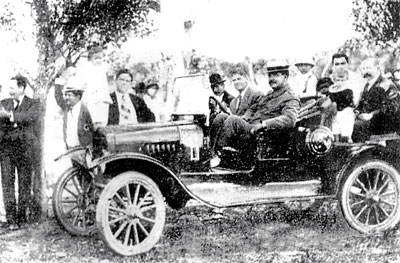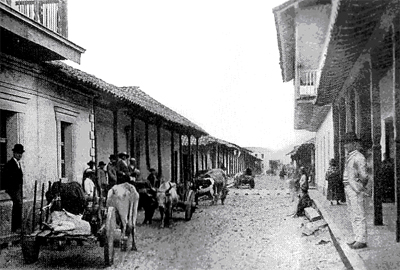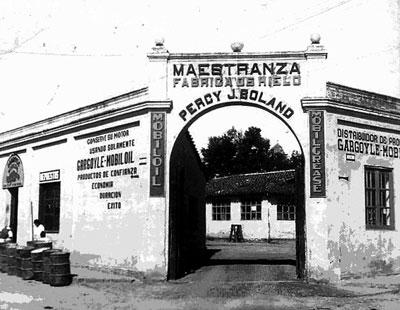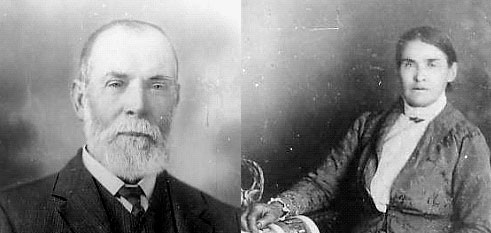|
Emigration
There is no known record of the
birth of John Boland, but from the dates of birth of his
children, he was probably born about 1805 or earlier. He is
said to have married Margaret Kelly at 'Llemonahan' on 27
February 1832, and they had four children, James, John (jun.),
Bridged and Mathew. Mathew Boland (1840-1917) was the first to
travel to Australia on an assisted passage on The Light
Brigade and arrived in Sydney on 21 May 1867. Mathew
stated on the shipping list that his father was a farmer in 'Lumcloon,'
Cloghan, in King's County (present-day County Offaly), and
that his mother was dead.
When Mathew first arrived he went
to work on the gold fields at Sofala near Bathurst and later
moved to Molong district where he worked on the land for some
time, before he was able to select a plot of land at Amaroo in
1870, which he named 'Calabash' after the hill on the plot
which looked like a pumpkin. In 1877, Mathew married Sarah
Monaghan, a native of Bathurst, Australia, and they had four
children: William, John, Elizabeth Miriam Jane and Patrick
(Percy), the youngest, born in 1886 and died in Santa Cruz,
Bolivia in 1958.
From Australia to Bolivia:
The Adventure
On the first journey it is clear
that Mathew Boland emigrated from Ireland in search of more
prosperous climes. The second trip, by his son to America, is
more difficult to explain. However, a hypothesis can be
formulated thanks to information obtained in Australia. It was
the youngest of Mathew's sons, Patrick James, that left the
land of his birth. He was born in 1886 and known in Bolivia as
Percy James Boland. The reasons why he changed his name from
Patrick James to Percy James are not known, but it can be
assumed that the change eased pronunciation of his name. What
is sure is that the 17 March (St. Patrick's Day) was always a
reason for a party in his house. These days, his descendants
continue to celebrate that date with a gathering of all of the
members of the Boland clan, currently over 120 people.
Percy's journey all the way to
Santa Cruz, Bolivia, was long and difficult. Only a great
adventurous spirit could inspire and sustain such a trip, in
view of the conditions of the period. In 1907, he arrived in
San Francisco, California, after the 1906 earthquake, on a
boat with a cargo of horses. The opportunity of work which
existed in America was possible because of the combination of
his experience in agriculture and breeding at the farm in
Amaroo, and his studies as a fitter and turner in Orange, New
South Wales, equivalent to mechanical engineering today.
|

The child Percy Boland
Rodríguez, supported by his father Percy J. Boland, on
the mudguard of the first car that arrived in Santa
Cruz. |
An understanding of motors was
very much in demand in those times. It was the era of the
production and export of the first cars from the USA. That is
how a new challenge emerged: that of accompanying the first
cars that arrived in Argentina, in 1911. At the beginning of
the twentieth century, the first car arrived in Santa Cruz.
Sitting on the mudguard of the vehicle was the child Percy
Boland Rodríguez, supported by his father Percy J. Boland.
Unfortunately very little is known
of the period between his arrival in the USA in 1907 and his
ultimate settlement in Santa Cruz, Bolivia, in 1912. It was in
the latter region that Percy Boland left an enduring mark,
where he settled, and where he died on 6 March 1958. The car
trip from Buenos Aires, Argentina to Santa Cruz, Bolivia, took
him six months. He was contracted to participate in this trip
because he was able to fix the motor and produce parts if
necessary. It is possible that this long and trying time was
one of the reasons why he was reluctant to face the return
journey. Or perhaps he fell in love with the place and its
women, famous for their beauty...
At the beginning of the twentieth
century, the population of Santa Cruz was about 18,300
inhabitants, and around 1922, it had reached 20,000, according
to information published by the Society of Geographic and
Historical Studies. The roads and paths leading to other
departments in Bolivia and to other countries were not yet
built, and it was a remote and inaccessible region.
|

Typical image of coaches in
1895. In the Santa Cruz of old, the main mode of
transporting cargo was a coach drawn by oxen, even today
they can be seen carrying agricultural produce from the
countryside to the outskirts of the city. |
Percy Boland arrived in a
small town, a little village, markedly backward in comparison
with the important cities of the high plains. It is possible
that because of the isolation of the region, anyone arriving
from foreign countries was held in high estimation, even more
so if they were 'gringos' from the USA. Percy spoke only
English and had lived in San Francisco, making it very easy to
believe that he was a US-American citizen, also due to the
fact that Australia was unknown to most people in Bolivia. The
esteem in which foreigners were held facilitated his rapid
integration into the highest echelons of
cruceño
society, intensified by the founding
of a family and the arrival of his children.
Percy's legacy in Santa Cruz
Like many descendants of Irish
people who settled in remote regions of Latin America, Percy
Boland was a pioneer. He developed activities that were
hitherto unknown at those latitudes. In the period in which he
arrived, Santa Cruz was a backward and isolated town. The
eastern region, today the most thriving region in Bolivia, was
overlooked by the central government in the West with regard
to infrastructure and, above all, roads. It was only in the
mid-1950s that the road to other important centres was
completed and the work on the railway was finalised,
connecting this region to Brazil.
Since then there has been a period
of accelerated and progressive growth, and agriculture is
prospering because of the commercialisation of produce. The
isolation of the region was gradually alleviated due to the
efforts of the inhabitants of Santa Cruz. It was necessary to
form cooperatives to install electricity and a telephone
service. An overview of the period highlights the significance
of Percy's work. He is connected to factors that undoubtedly
assisted in the progress and modernisation of the Department.
In the region, Patrick/Percy
Boland founded:

First car repair shop and
ice manufacturing plant in Santa Cruz. |
● The first 'maestranza'
(mechanics' workshop), five blocks south of the main square in
Santa Cruz.
● The first ice factory,
transforming habits and customs due to the torrid climate of
the region.
● The first power plant, that
began to function in 1923, from which extended the first
distribution network, the installation of public lighting and
the first domestic connections.
● The construction and
administration of the first swimming pool in the city (Hawai
Pool).
Finally, there are indications
that he was involved in the construction of the first oil
refinery in Bolivia.
The town of the dusty streets was
transformed into a modern urban centre, today considered the
economic engine of Bolivia. Santa Cruz is the department that
receives the largest amount of internal migrants from other
Bolivian cities. Santa Cruz has its own particular way of
life, developed throughout four centuries, in which Spanish
roots, the influence of the tropical environment, the spirit
of adventure and the perception that there was an unlimited
land to be conquered, the familiarity and the simplicity of
the customs and other diverse elements, all play a part in
giving that unmistakable stamp to this part of the Bolivian
nation.
The first descendants of
Percy
The second son of Percy was Percy
Junior, faithful heir of the characteristic spirit and
impetuousness of the Irish. He also contributed greatly to the
community of Santa Cruz, as a gynaecologist and obstetrician,
trained in La Plata, Argentina, and a graduate of Harvard,
Boston in Public Health. He was also a founding and honorary
member of the Bolivian Society of Obstetrics and Gynaecology
and the Bolivian Society of Public Health. He was named
'Master of Latin American Gynaeco-Obstetrics' in the Dominican
Republic in 1984, and the maternity hospital in Santa Cruz
bears his name. He was president of the Pro Santa Cruz
Committee, the Santa Cruz Tennis Club and the Rotary Club. He
founded the Youth Exchange Programme of the Rotary Club and
was Governor of the 469 district of Rotary International. He
was also Vice-Chancellor of the state university 'Gabriel René
Moreno' and founded the Santa Cruz Federation of
Professionals. Percy Junior died in Santa Cruz in January
1994.
Percy Junior's sister Nelly
married at a young age, and was widowed shortly thereafter.
She had one son and six grandchildren. She died in Santa Cruz
in December 1996. Patsy married a colonel in the Bolivian
Army. She had just one daughter, who had four children. She
died in Santa Cruz in December 1989. Dolly married a
well-known lawyer in Santa Cruz and had one daughter and four
sons. She died in April 2006. Freddy, the youngest of the
children, married young. He had two sons and two daughters. He
had a successful career in insurance and died in Santa Cruz in
November 1987. Nancy also married a lawyer in Santa Cruz and
dedicated many years of her life to teaching in primary
schools. She has two sons and two daughters. Nancy and her
husband are now retired and share their time with their much
loved nine grandchildren.
Journey from Bolivia to
Argentina: Exile
Percy's eldest son Hernán was
attracted to politics from a very young age. At seventeen, he
enrolled as a volunteer to fight in the Chaco War against
Paraguay. He was taken prisoner, and his family took him for
dead, but to everyone's surprise he returned home. Years later
he received the Chaco War medal of honour, which filled him
with pride. As an adult, he founded a local political party,
the Workers' Union, with his friend Edmundo Roca, which was
later subsumed into the Revolutionary Nationalist Movement
(MNR), led by Víctor Paz Estenssoro. In Santa Cruz, Hernán was
President of the Banco Agrícola, Chief of Police and
legislator.
Bolivian history has a sad record
of changes of government. In the past sixty years, from 1946
to date, there were 45 changes. Interim governments and
military juntas were the most frequent. Constitutional
governments that completed their mandate were a rarity. This
helps to understand why Hernán fled to save his life after the
fall of President Gualberto Villarroel, who was murdered and
hanged in the public square of La Paz as a warning. Edmundo
Roca, with whom Hernán had founded the Workers' Union, was
murdered by violent groups who also looted his houses. In the
midst of this situation and thanks to the aid of certain
people, Hernán managed to escape to Argentina, a place to
which his wife Raquel and six-month-old daughter Julia arrived
some months later. All of their belongings had been robbed or
destroyed and their bank accounts had been blocked.
However, despite these adverse
circumstances, Hernán managed to find his way thanks to his
diligence and his personality, which inspired affection and
friendships at every step. Hernán worked as a foreign
correspondent for the Santa Cruz newspaper El Deber. He
finally abandoned politics and integrated into the Argentine
community without difficulty, even though he always missed his
native country to which he returned just prior to his death,
at the age of sixty-two years. Political activity in a country
convulsed by coups d'état and changes of government was what
obliged him to live in exile in Argentina from 1946 until he
died on 3 April 1976, just days after the fall of Isabel Perón
and the beginning of one of the darkest periods in Argentine
history when 30,000 people were disappeared.
Reunions
After Percy had died, it was his
son Percy who reinitiated contact with the Australian branch
of the family, thanks to his job in charge of the Youth
Exchange Programme of the Rotary Club in Santa Cruz and the
work of another Rotarian in Australia whom he had informed of
the nationality of his father. This person took on the task of
tracing the Boland family in the region where they were said
to have lived, Amaroo in New South Wales. He found their
descendants in a city very nearby, Molong. The first contact
was maintained in the form of a periodic correspondence even
though they never got to know each other personally. Finally
in 1997, three representatives of the South American Bolands,
Martha and Marilyn (of Santa Cruz), and Julia (of Buenos
Aires) returned to the places where their grandfather Percy
had been born and studied, and met their Australian aunts,
uncles and cousins. A couple of years previously, Julia had
visited Tullamore, County Offaly and had met her cousin John
Looby, a descendant of Bridged Boland and Michael Looby who
had remained in Ireland. She was the first South American
Boland to visit the places from which her ancestors had
departed.
Julia Boland and Marilyn Boland
Translated by Claire Healy
References
- Chiquitos un paseo por su
Historia (Santa Cruz, Bolivia: Fondo Editorial APAC,
2004).
- Parejas Moreno, Alcides
(ed.). Santa Cruz: Tiempo y Espacio
(Santa Cruz, Bolivia: Cooperativa Rural de Electrificación,
2000).
- Prologue to John Boland's
publication County Offaly. Ireland. His Descendants.
- Siles
Salinas, Jorge.
Bolivia
(Barcelona: Ediciones Castell S.A., 1982), pp. 126-129.
Acknowledgements
We are particularly grateful to
John F. Boland of Australia and Percy Boland of Bolivia, who
made it possible to tell this story. John, or 'Uncle Jack,'
because he was interested in researching his own origins,
resulting in a valuable and comprehensive publication of the
results of his search. Percy, because of those twists of fate,
was the one who united the two distant branches in Australia
and South America, through a correspondence that he maintained
for many years with his cousins in Australia. This sustained
contact led to two of his daughters (Martha and Marilyn) and
one niece (Julia), grandchildren of the first Percy, the
Australian of Irish origin who settled in Bolivia, visiting
Australia, the birthplace of their grandfather. |




